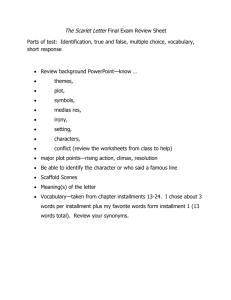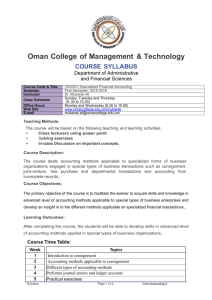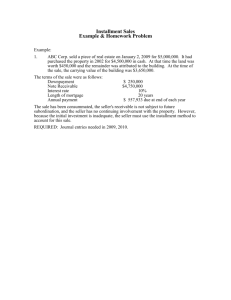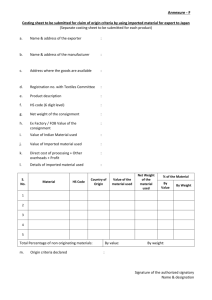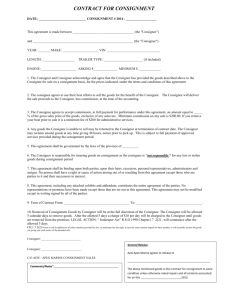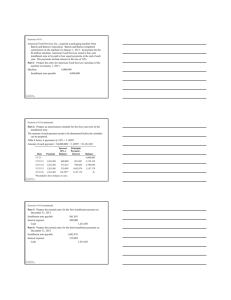Complexities of Revenue Recognition
advertisement
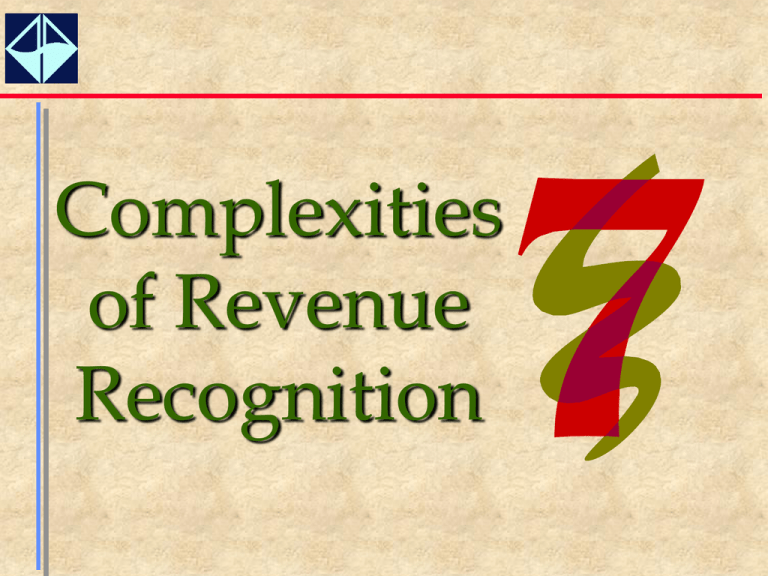
Complexities of Revenue Recognition 2 Learning Objectives Identify the primary criteria for revenue recognition. Explain when revenue is appropriately recognized prior to delivery of goods or services through percentage-of-completion accounting. Record journal entries for long-term construction-type contracts using percentage-of-completion and completedcontract methods. 3 Learning Objectives Record journal entries for long-term service contracts using the proportional performance method. Explain when revenue is recognized after delivery of goods or services through installment sales, cost recovery, and cash methods. 4 Learning Objectives EXPANDED MATERIAL: Describe accounting for the transfer of assets prior to the recognition of revenue with the deposit method and consignment sales. 5 Revenue Recognition Criteria FASB’s two criteria for recognizing revenues and gains: They are realized or realizable, and They have been earned through substantial completion of the activities involved in the earnings process. 6 Revenue Recognition Criteria This most often occurs Both of these when goodscriteria are generally areormet at the delivered when pointare of rendered. sale. services Revenue Recognition-Exceptions • A product or service was provided without receiving a valid promise of payment from customer. • The company has not provided the product or service. 7 8 Revenue Recognition--IAS 18 A company should recognize revenue from the SALE OF GOODS when all of the following conditions have been satisfied: The significant risks and rewards of ownership of the goods have been transferred to the buyer and the selling company retains no effective control over what happens to the goods, Both the amount of the revenue and of the costs associated with the transaction can be reliably measured, and It is probable that the economic benefits of the sale will flow to the selling company. 9 Revenue Recognition--IAS 18 A company should recognize revenue from the RENDERING OF SERVICES when both of the following conditions have been satisfied: The total amount of the revenue, the total amount of the costs, and the stage of completion of the transaction can be reliably measured, and It is probable that the economic benefits of the transaction will flow to the company rendering the services. Revenue Recognition-Exceptional Cases • Long-Term Contracts • Uncertain Collections • Deposit Method • Consignment Sales 10 Long-Term Contracts-Recognition Choices • Completed-Contract Method: recognize all requires incomepercentage-ofwhen project is GAAP completion method unless certain completed. criteria are not met. • Percentage-of-Completion Method: recognize revenue throughout the term of the contract. 11 Percentage-ofCompletion Criteria Dependable estimates of: – revenues. – costs. – progress toward completion. Contract clearly specifies: – enforceable rights of the parties. – consideration to be exchanged. – manner and terms of settlement. 12 Percentage-ofCompletion Criteria The buyer can be expected to satisfy obligations under the contract. Contractor can be expected to perform the contractual obligation. 13 Percentage-of-Completion-General Concepts • Recognize revenue throughout life of the contract. • Revenue recognized is a function of how complete the project is. • Costs are charged to an inventory account: Construction in Process (CIP). • Profits are charged to CIP. • CIP is valued at net realizable value. • Any anticipated loss is booked for the full amount of the loss when it becomes measurable. 14 15 Percentage-of-Completion • Input measures: Cost-to-cost method where the degree of completion is determined by comparing costs already incurred with the most recent estimates of total expected costs to complete the project. Engineers are often called in to help provide estimates. 16 Percentage-of-Completion Costs incurred to date 2001 __ $ 72,000 2002 $192,000 At the beginning of the contract, costs are expected to be incurred each year as shown. 2003 $240,000 17 Percentage-of-Completion Costs incurred to date Estimated costs to complete Total estimated costs 2001 _ $ 72,000 2002 $192,000 2003 $240,000 168,000 48,000 0 $240,000 $240,000 $240,000 Total cost of the project at completion is expected to be $240,000. The difference between the costs incurred to date and the total estimated costs at completion is defined as the estimated costs remaining to complete the project. 18 Percentage-of-Completion 2001 $ 72,000 2002 $192,000 2003 $240,000 168,000 48,000 0 Total estimated costs $240,000 $240,000 $240,000 Percentage complete 30% 80% 100% Costs incurred to date Estimated costs to complete Percentage complete is the ratio of costs incurred to date to total estimated costs at completion. 19 Percentage-of-Completion 2001 $ 72,000 2002 $192,000 2003 $240,000 168,000 48,000 0 Total estimated costs $240,000 $240,000 $240,000 Percentage complete 30% 80% 100% $ 60,000 $ 60,000 $ 60,000 Costs incurred to date Estimated costs to complete Estimated total income Total Contract $300,000 Estimated total income is the difference between the contract price and total expected costs. Assume the contract price in this example is $300,000. 20 Percentage-of-Completion 2001 $ 72,000 2002 $192,000 2003 $240,000 168,000 48,000 0 Total estimated costs $240,000 $240,000 $240,000 Percentage complete 30% 80% 100% Estimated total income $ 60,000 $ 60,000 $ 60,000 Estimated total income to date $ 18,000 $ 48,000 $ 60,000 Costs incurred to date Estimated costs to complete Estimated total income to date is computed based on the cumulative percentage complete. 21 Percentage-of-Completion 2001 $ 72,000 2002 $192,000 2003 $240,000 168,000 48,000 0 Total estimated costs $240,000 $240,000 $240,000 Estimated total income to date $ 18,000 $ 48,000 $ 60,000 0 18,000 48,000 $ 18,000 $ 30,000 $ 12,000 Costs incurred to date Estimated costs to complete Income recognized in the current period is the Percentage complete 30% 80% 100% difference between total income to date and Estimated total income 60,000 $ 60,000 $ 60,000 income previously $recognized. Less:Iincome previously recognized Income recognized this period 22 Percentage-of-Completion 2001 $ 72,000 2002 $192,000 2003 $240,000 168,000 48,000 0 Total estimated costs $240,000 $240,000 $240,000 Percentage complete 30% 80% 100% Estimated total income $ 60,000 $ 60,000 $ 60,000 Estimated total income to date $ 18,000 $ 48,000 $ 60,000 0 18,000 48,000 $ 18,000 $ 30,000 $ 12,000 Costs incurred to date Estimated costs to complete Less: Income previously recognized Income recognized this period 23 Percentage-of-Completion 2001 Construction in Progress…………. 72,000 Materials, Cash, etc…………... 72,000 To record costs incurred. Accounts Receivable…………….. 100,000 Progress Billings on Construction Contracts……… 100,000 To record billings (amount assumed). Cash………………………………. 90,000 Accounts Receivable………….. 90,000 To record cash collections (amount assumed). 24 Percentage-of-Completion 2002 Construction in Progress………… 120,000 Materials, Cash, etc………….. 120,000 To record costs incurred. Accounts Receivable……………. 140,000 Progress Billings on Construction Contracts……... 140,000 To record billings (amount assumed). Cash……………………………… 125,000 Accounts Receivable………… 125,000 To record cash collections (amount assumed). 25 Percentage-of-Completion 2003 Construction in Progress…………. 48,000 Materials, Cash, etc…………... To record costs incurred. Accounts Receivable…………….. 60,000 Progress Billings on Construction Contracts……… To record billings (amount assumed). Cash………………………………. 85,000 Accounts Receivable………….. To record cash collections (amount assumed). 48,000 60,000 85,000 Revenue Recognition-Exceptional Cases • Long-Term Contracts • Uncertain Collections • Deposit Method • Consignment Sales 26 Uncertain Collections-Recognition Alternatives Installment Sales Method: Recognizes revenues and related expenses as cash is received (used when collection is somewhat uncertain). Cost Recovery Method: No income is recognized on sale until the cost of the item sold is recovered through cash receipts (used when collection is very uncertain). Cash Method: Recognizes all expenses immediately as incurred and all revenues only when cash is collected. 27 Uncertain Collections--Comparison of Recognition Methods Method Timing of Revenue Recognition Full Accrual At point of sale Installment Sales At collection of cash (portion of receipt) Cost Recovery At collection of cash (after all costs have been recovered) Cash At collection of cash Treatment of Costs Revenue at point of sale Defer and match against revenue as cash is collected Defer and match against cash receipts Charge to expense as incurred 28 29 Installment Sales Method The installment sales method is used most commonly in cases of real estate sales. Example: Installment Sales Method George sells merchandise on the installment basis. Uncertainty of collection makes use of the installment method necessary. Use the accompanying data to prepare George’s journal entries. 30 Example: Installment Sales Method Sales Cost of Sales Gross Profit Gross Profit Percentage Cash Collection 2001 Sales 2002 Sales 2001 $150 100 $ 50 33.33% $ 30 31 2002 $200 140 $ 60 30% $ 75 $ 70 Example: Installment Sales Method 32 2001: Accounts Receivable--2001……... 150 Installment Sales………………. 150 Cost of Installment Sales………... 100 Inventory………………………. 100 Cash……………………………… 30 Accounts Receivable--2001…... 30 Example: Installment Sales Method 33 2001: Installment Sales…………………. 150 Cost of Installment Sales………. 100 Deferred Gross Profit--2001…... 50 Deferred Gross Profit--2001……... 10 Realized Income……………….. ($30 x 33.33%) 10 Example: Installment Sales Method 34 2002: Accounts Receivable--2002……….. 200 Installment Sales………………… Cost of Installment Sales………….. 140 Inventory………………………… Cash………………………………... 145 Accounts Receivable--2001……... Accounts Receivable--2002……... 200 140 75 70 Example: Installment Sales Method 35 2002: Installment Sales…………………... 200 Cost of Installment Sales………... Deferred Gross Profit--2002…….. 140 60 Deferred Gross Profit--2001………. 25 Deferred Gross Profit--2002………. 21 Realized Gross Profit on Installment Sales……………….. 46 36 Example: Cost Recovery Method Assume George has to use the cost recovery method, but all sales and collections remain the same. 37 Example: Cost Recovery Method 2002: All entries are the same except do not book the entry to gross profit. Deferred Gross Profit--2001……….. 5 Realized Gross Profit on Installment Sales……………….. 5 Revenue Recognition-Exceptional Cases • Long-Term Contracts • Uncertain Collections • Deposit Method • Consignment Sales 38 Deposit Method--General Requirement Used when cash is received before a sale is completed. All revenue is initially deferred. Seller retains property sold as a recognized asset until sale is completed. Revenue is recognized when sale is completed. 39 40 Deposit Method and Franchises Relates primarily to initial franchise fees. Franchiser defers initial fee at time cash is received. Franchiser recognizes initial fee revenue when “substantial performance” of services is achieved. Franchiser may use any appropriate recognition method once substantial performance is achieved. 41 Example: Franchise Mary sells Bob a franchise for $1,000 cash on June 1. Substantial performance is agreed upon that Mary will complete $700 of renovation on Bob’s restaurant (which occurs on July 10). Prepare Mary’s journal entries. 42 Example: Franchise June 1 Cash……………………………... 1,000 Deposit on Franchise (or Unearned Franchise Fee)…... July 10 Cost of Franchise Fee Revenue…. 700 Cash…………………………. Deposit on Franchise (or Unearned Franchise Fee)……… 1,000 Franchise Fee Revenue……... 1,000 700 1,000 Revenue Recognition-Exceptional Cases • Long-Term Contracts • Uncertain Collections • Deposit Method • Consignment Sales 43 Consignment Sales-General Principles • Definitions: – Consignee: Title holder/seller of merchandise. – Consignor: Merchandise selling agent. • Consignor does not recognize revenue upon shipment to consignee. • Consignor accounts for consigned goods in separate Inventory on Consignment account. 44 Consignment Sales-General Principles • Consignee does not recognize consigned goods as inventory. • Consignor records all pre-sale expenses as Inventory on Consignment. • Consignor recognizes revenue when informed of a sale by consignee. • Consignee recognizes revenue only for consignment commission. 45 46 Example: Consignment Sales Bob agrees to consign goods worth $1,000 to Lucy. Lucy agrees to sell the goods at her store for a 5 percent of net sales consignment commission and reimbursement of selling expenses.the The next several slides demonstrate transactions and journal entries for Bob and Lucy throughout the consignment cycle. (All numbers are assumed.) 47 Example: Consignment Sales Transaction: Shipment of Goods Entry in Bob’s (consignor’s) books: Inventory on Consignment…… 1,000 Finished Goods Inventory….. 1,000 Entry in Lucy’s (consignee’s) books: None--memorandum inventory control record. 48 Example: Consignment Sales Transaction: Incurrence of $200 of selling expenses by Lucy. Entry in Bob’s books: Inventory on Consignment…. 200 Consignee Payable……….. 200 Entry in Lucy’s books: Consignor Receivable………. 200 Cash………………………. 200 49 Example: Consignment Sales Transaction: Sale of merchandise for $2,000. Entry in Bob’s books: None. Entry in Lucy’s books: Cash……………………… 2,000 Consignor Payable…….. 2,000 50 Example: Consignment Sales Transaction: Lucy notifies Bob of the sale and sends him net cash proceeds. Entry in Bob’s books: Commission Expense…………... 100 Cash…………………………….. 1,700 Consignee Payable……………... 200 Cost of Goods Sold…………….. 1,000 Consignment Sales Revenue…. 2,000 Inventory on Consignment…… 1,000 51 Example: Consignment Sales Entry in Lucy’s books: Consignor Payable…………. 2,000 Cash………………………. 1,700 Commission Revenue…….. 100 Consignor Receivable…….. 200 52 The End
